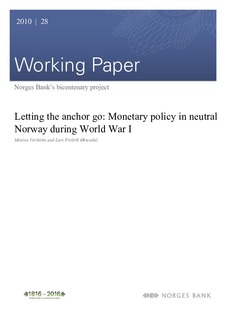| dc.contributor.author | Værholm, Monica | |
| dc.contributor.author | Øksendal, Lars Fredrik | |
| dc.date.accessioned | 2018-05-08T07:10:57Z | |
| dc.date.available | 2018-05-08T07:10:57Z | |
| dc.date.issued | 2010 | |
| dc.identifier.uri | http://hdl.handle.net/11250/2497433 | |
| dc.description.abstract | Introduction:
For later generations, August 1914 has become a watershed in monetary history. In a matter of days, the belligerent and neutral countries of Europe alike suspended the gold standard. The international monetary regime that had served the world economy for close to four decades was no more. Everywhere domestic fiat money became the order of the day. Even more importantly, the war brought a fundamental change in the priorities of monetary policy: National objectives triumphed over monetary stability. | nb_NO |
| dc.language.iso | eng | nb_NO |
| dc.publisher | Norges Bank | nb_NO |
| dc.relation.ispartofseries | Working Papers;28/2010 | |
| dc.rights | Attribution-NonCommercial-NoDerivatives 4.0 Internasjonal | * |
| dc.rights.uri | http://creativecommons.org/licenses/by-nc-nd/4.0/deed.no | * |
| dc.title | Letting the Anchor Go: Monetary Policy in Neutral Norway During World War I | nb_NO |
| dc.type | Working paper | nb_NO |
| dc.description.version | publishedVersion | nb_NO |
| dc.subject.nsi | VDP::Samfunnsvitenskap: 200::Økonomi: 210::Samfunnsøkonomi: 212 | nb_NO |
| dc.source.pagenumber | 34 | nb_NO |
| dc.relation.project | Bicentenary Project | nb_NO |
| dc.relation.project | Tohundreårsjubileum | nb_NO |

